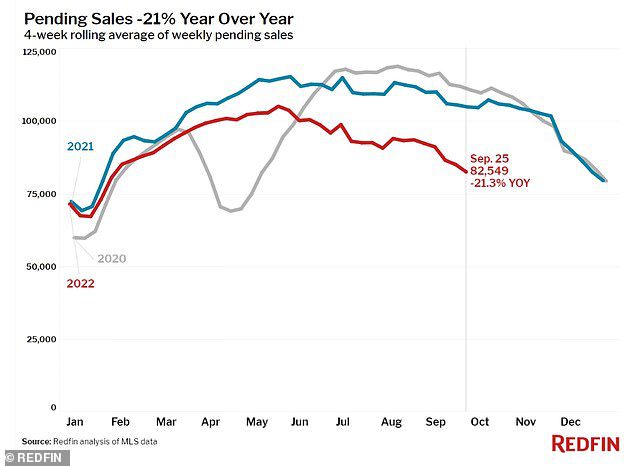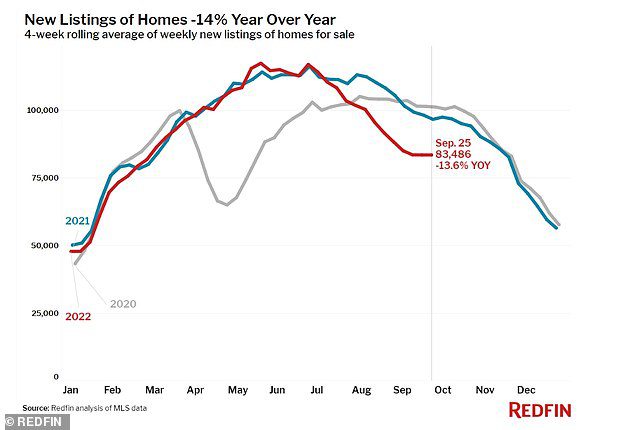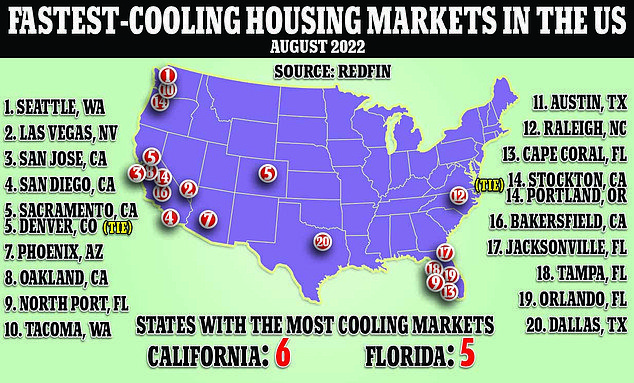The average homeowner in the United States has seen monthly mortgage payments rise by 15 percent, or $337, according to a shocking new report from Redfin.
The report goes on to say that the rise in mortgage rates of about seven percent is the highest since July 2007, shortly before the crash that caused the Great Recession.
This causes potential homebuyers to cool off and decide not to buy in the current market.
In addition, homes are staying on the market for much longer which leads to landlord prices dropping to the highest level since 2015.
Sales pending since January have not been at the current low while the amount of below-market homes sold is at its highest level since 2020. New listings are down 14 per cent from the same time in 2021.
“It is imperative that home sellers react quickly and aggressively to the shifting market,” the report quoted Jason Alim of Redfin as saying.
He continued: “This means adjusting your prices immediately if you want to be competitive and attract offers from a smaller group of qualified homebuyers. If your home isn’t the “belle of the ball” in your area, you’ll need to lower the price to sell it. “
According to a Redfin report, mortgage rates increasing by nearly seven percent are the highest since July 2007, shortly before the crash that triggered the Great Recession.

One of Redfin’s main indicators of the decline in potential buyers is the fact that “homes for sale” as a search term on Google fell 33 percent last September compared to the same period last year.

New listings for homes are down 14% from the previous year
One of Redfin’s main indicators of the decline in potential buyers is the fact that “homes for sale” as a search term on Google fell 33 percent last September compared to the same time last year.
Other factors are dropping, such as home tour requests combined with mortgage buying applications.
At the time of writing, the median home price in the United States is $369,250, which is a seven percent year-over-year increase.
Sale prices in crime-ridden San Francisco fell four percent while they were down 11 percent in New Orleans.
Mortgage buyer Freddie Mac reported Thursday that the 30-year average prime rate increased to 6.70 percent from 6.29 percent last week. In contrast, the rate was 3.01 percent a year ago.
The average interest rate on 15-year fixed-rate mortgages, which is popular with those looking to refinance their homes, jumped to 5.96 percent from 5.44 percent last week.
The rapid rise in mortgage rates threatens to sideline more homebuyers after they doubled in 2022. Last year, potential homebuyers were eyeing rates well below 3 percent.
Freddie Mac noted that for a typical mortgage amount, a borrower who locks in at the higher end of the weekly rates range over the past year will pay several hundred dollars more than a borrower who locks in at the lower end of the range.

A new study reveals that the housing market in Seattle is slowing faster than any other market in the country — as cash-strapped buyers increasingly shy away from home purchases.
Last week, the Federal Reserve raised its benchmark borrowing rate by another three-quarters of a point in an effort to constrain the economy, its fifth increase this year and its third consecutive increase of 0.75 percentage points.
Nowhere else in the housing sector is the effect of Fed action more pronounced. Existing home sales have been declining for seven consecutive months as the rising cost of borrowing money puts homes out of reach for more people.
The government reported Thursday that the US economy, hurt by rising consumer prices and higher interest rates, contracted at an annual rate of 0.6% from April through June. This was unchanged from the previous estimate for the second quarter.
Federal Reserve officials expect that they will raise the benchmark interest rate to nearly 4.4% by the end of the year, a full point higher than they had envisaged as recently as June. They expect to raise the rate again next year to around 4.6%. This will be the highest level since 2007.
By raising borrowing rates, the Federal Reserve makes getting a mortgage and a car or business loan more expensive. Consumers and businesses are then supposed to borrow and spend less, cooling the economy and slowing inflation.
Mortgage rates do not necessarily reflect Fed rate increases, but they tend to track the yield on 10-year Treasuries. This is influenced by a variety of factors, including investor expectations for future inflation and global demand for the US Treasury.

“Reader. Infuriatingly humble coffee enthusiast. Future teen idol. Tv nerd. Explorer. Organizer. Twitter aficionado. Evil music fanatic.”
